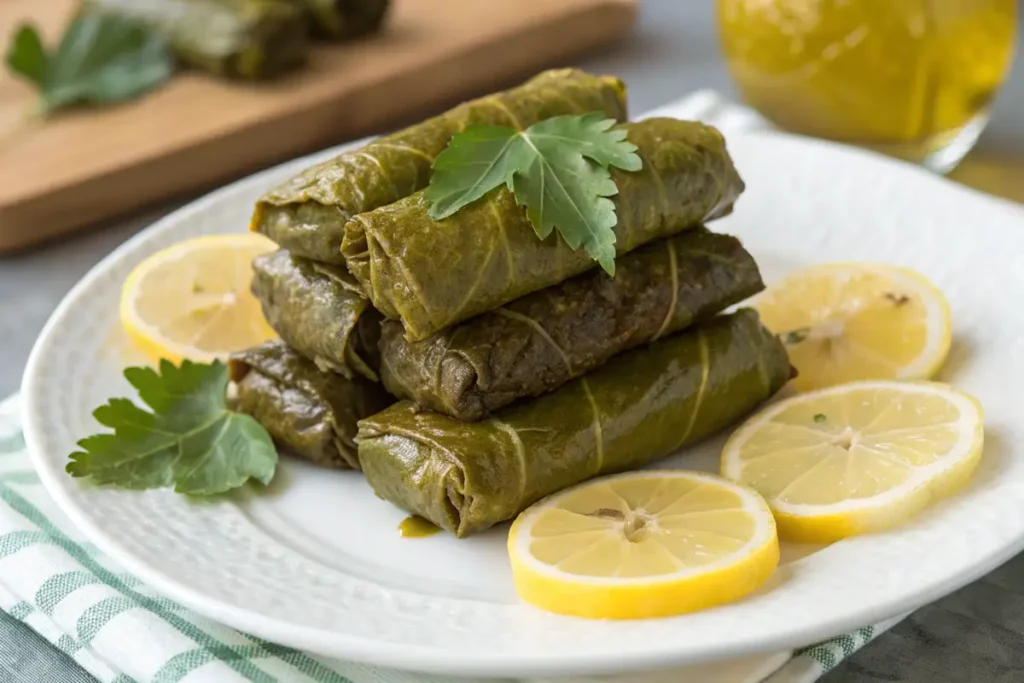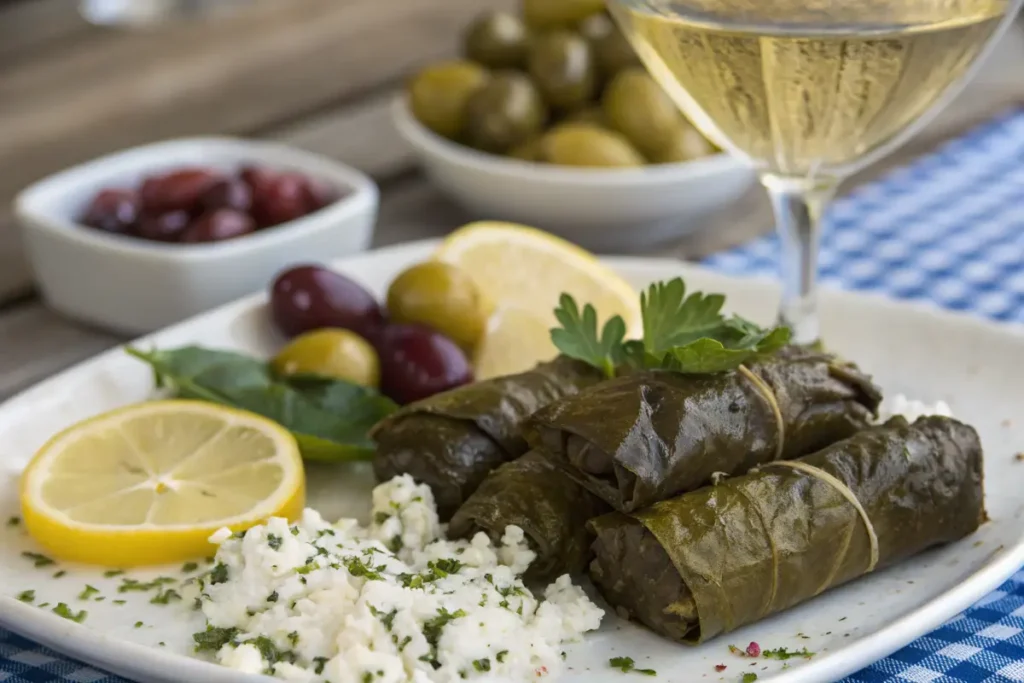Dolma vs. Dolmades may make you question whether there is a true distinction between these two delectable stuffed foods that have been consumed for centuries in many cultures.
We’ll dissect the background, components, methods of preparation, and cultural significance of both dolma and dolmades in this comprehensive guide. You’ll learn where they came from, how they differ, and why food lovers around the world can’t get enough of these Mediterranean bites.
By the end, you’ll know exactly which to serve at your next dinner party — or better yet, how to make both like a pro.
Looking for inspiration? Try our Greek Dolmades guide to see how it’s done the traditional way.
Origins of Dolma vs. Dolmades
History of Dolma: Turkish Culinary Roots
The word dolma comes from the Turkish verb dolmak, meaning to fill or to stuff. The origins of dolma can be traced to the Ottoman Empire, where chefs mastered the technique of packing savory rice or minced meat fillings into vegetables, grape leaves, and even fruit.
Today, dolma recipes are cherished and lovingly handed down through the generations in Turkish homes. Some regions use lamb or beef for extra flavor, while others focus on rice and herbs for a lighter touch.
The difference between dolmas and dolmades starts with this Turkish foundation.
Dolmades in Greek Cuisine: How They Evolved
In Greece, dolmades is the plural form of dolmas — but over time, it’s become a term of its own. Dolmades became a mainstay at feasts, weddings, and family get-togethers after the Greeks adopted the Ottoman idea.
Greek dolmades, in contrast to some Turkish ones, frequently include fresh mint, dill, and lemon juice for a zesty Mediterranean flavor. To add more regional flavor, some islands replace grape leaves with cabbage or even zucchini blossoms.
Don’t miss our Pairing Dolmades with Greek Wines for the perfect meze spread.
Dolma vs Dolmades: Ingredients Breakdown
Common Ingredients in Dolma
When it comes to dolma, the variety is endless. Turkish dolma often uses grape leaves, bell peppers, eggplants, or zucchinis as edible vessels for stuffing.
Rice, finely chopped onions, pine nuts, currants, fresh herbs like dill and parsley, and aromatic spices like cinnamon or allspice are typically included in the filling.
For a substantial, high-protein bite, some versions—particularly in Anatolia—incorporate minced beef or lamb. Olive oil is also very important because it keeps dolma flavorful and moist.
The distinctive flavor that distinguishes dolmas and dolmades is produced by this complex blending of grains, herbs, and occasionally meat.
What Makes Dolmades Unique
Greek dolmades, on the other hand, stick closer to a rice-and-herb filling that feels fresh and light.
Dill, mint, and scallions bring bursts of green flavor, while a squeeze of lemon juice cuts through any heaviness. Many Greek cooks swear by using only the most tender young grape leaves, which are softer and less bitter than mature ones.
Unlike some Turkish dolma, dolmades are more commonly vegetarian, although regional recipes may include minced meat for special occasions.
Check out our How to Roll Grape Leaves if you want perfectly shaped dolmades every time.

How to Prepare Dolma vs. Dolmades
Traditional Dolma Preparation Methods
Preparing dolma vs. dolmades always starts with choosing fresh grape leaves or seasonal vegetables to stuff. For classic Turkish dolma, grape leaves are washed and blanched to make them tender.
If you’re making dolma with vegetables like bell peppers, zucchini, or eggplants, they’re hollowed out to hold the flavorful stuffing. The big difference between dolmas and dolmades often comes down to the filling.
Traditional dolma fillings blend rice, minced lamb or beef, pine nuts, onions, currants, and warm spices like cinnamon and allspice. Everything is sautéed in rich olive oil for deep flavor.
Once filled, dolma are packed tightly in a pot, covered with extra grape leaves, and simmered with lemon juice and olive oil. This is why Turkish dolma stay juicy and fragrant, making dolma vs. dolmades a true culinary debate.
Rolling Grape Leaves for Dolmades
If you want to know the real difference between dolma vs. dolmades, watch how Greeks roll grape leaves.
For dolmades, the grape leaves are arranged shiny side down, the rice-and-herb filling is added, then rolled snug like a tiny burrito. This rolling method helps keep dolmades neat while cooking.
Greeks often cook dolmades slowly in lemony broth, letting the flavors develop fully.
While dolmas may have meat, dolmades lean more vegetarian but stay packed with fresh dill, mint, and lemon zest. For more stuffed recipes beyond dolma vs. dolmades, check out our Macedonian Stuffed Peppers Recipe.
Regional Variations — Dolma vs. Dolmades
Regional Twists in Turkey
Across Turkey, dolma isn’t just one dish — it’s dozens of regional twists. In the Aegean region, dolma might be packed with fresh herbs, pine nuts, and currants for a sweet-and-savory balance.
In Eastern Turkey, hearty dolmas include minced lamb and bold spices like sumac. This shows why the difference between dolmas and dolmades matters dolma covers a huge variety of local recipes.
Some cooks even wrap dolma in chard or cabbage when grape leaves are out of season.
Greek Islands’ Dolmades Styles
Greek dolmades have their own local spin too. On the Greek islands, cooks often use young, tender grape leaves harvested in spring.
Some islands swap grape leaves for zucchini flowers, cabbage, or even vine shoots. No matter the variation, Greek dolmades always highlight fresh herbs and that signature lemony tang.
Want to expand your dolma vs. dolmades knowledge? Don’t miss our Vegan Dolmades Recipe for a fresh, meat-free take.
Are Dolma Always Vegetarian?
Vegetarian vs. Meat-Filled Dolma
When contrasting dolma and dolmades, one important question is whether or not they are always vegetarian.
In actuality, minced lamb or beef is frequently used in traditional dolma recipes in Turkey, particularly in the Eastern and Southeastern regions. Rich and filling, meat-filled dolma are frequently served warm with yogurt.
However, a lot of home cooks also prepare vegetarian dolma, which is a lighter, plant-based dish made with rice, fresh herbs, pine nuts, and spices.
So, this is where the difference between dolmas and dolmades begins: a dolma can be either.
Vegan Dolmades Options
In Greece, dolmades lean more vegetarian by default. Most dolmades are stuffed with rice, dill, mint, and scallions, then simmered in lemony olive oil.
Vegan dolmades skip meat altogether and are popular during fasting periods or when served cold as meze.
For a contemporary twist, some Greek chefs experiment with fillings like quinoa or lentils. Are you looking for new perspectives?
Discover how various regions keep dolma vs. dolmades thrilling by reading our Dolmades Around the Mediterranean article.

Cultural Significance — Dolma vs. Dolmades
Dolma in Turkish Celebrations
In Turkey, dolma is more than just food; it’s a custom. Families get together to stuff peppers or grape leaves, particularly for special occasions like Eid or weddings. Dolma is a representation of hospitality and generosity.
Every visitor is given a plate, either warm or cold, with fresh bread or yogurt on the side. Dolma has a long history in Turkish festivities, which demonstrates why the difference between dolmas and dolmades is significant.
Dolmades at Greek Feasts
Greek dolmades bring people together too. They’re staples at Easter, name day feasts, and summer gatherings. Rolling grape leaves becomes a family affair, with recipes passed down through generations.
Greeks love serving dolmades as part of a meze spread alongside feta, olives, and fresh bread. That lemony bite makes dolmades refreshing even on hot days.
Pairing & Serving Dolma and Dolmades
Best Sides for Dolma
When serving dolma, simple sides make the flavors pop. Crispy bread, cool yogurt, and fresh herbs all go well with Turkish dolma.
For added depth, some regions serve dolma warm with a sprinkling of melted butter and paprika.
Turkish dolma is frequently served as a main course rather than merely a side dish, demonstrating the difference between dolmas and dolmades here as well. To counterbalance the rich stuffing, serve with a crisp salad or tart pickles.
Pairing Dolmades with Greek Wines
On a meze platter, Greek dolmades look stunning. Their zesty, lemony flavor goes well with grilled pita, feta, and olives. Each bite of the dolmade is made refreshing by the crisp white wine, such as Assyrtiko, which cuts through the herbs and olive oil. In the summer, many Greek families serve chilled dolmades as a refreshing, tangy snack.

FAQs on Dolma vs. Dolmades
Are Dolma Always Vegetarian?
Not all the time. Depending on the area, traditional dolma can be either vegetarian or meat-filled. In Turkey, especially during festive feasts, dolma is frequently found packed with rice, herbs, and minced beef or lamb. A lot of families also prepare vegetarian dolma, particularly for lighter meals or during the summer. Therefore, keep in mind that Turkish dolma offers a wider variety of fillings than dolmades.
Why Do Greeks Call Them Dolmades?
In Greece, the word dolmades is simply the plural form of dolmas. But over time, dolmades has become its own identity. Greek dolmades are usually small grape leaf rolls stuffed with rice, fresh herbs, and citrusy flavors. While the term comes from Turkish dolma, Greeks gave dolmades their own twist. This difference between dolmas and dolmades shows how cultures adapt and shape a dish to fit their taste.
Final Thoughts: Dolma or Dolmades?
Which should you make first, Dolma or Dolmades? Turkish dolma with minced lamb may appeal to you if you’re in the mood for strong spices and deep flavors. Do you prefer something zesty and fresh? With their abundance of lemon and herbs, Greek dolmades are always a hit. These dishes, which share centuries of Mediterranean culinary history, unite people. You’re tasting a bit of tradition, so you can’t go wrong with either option.



